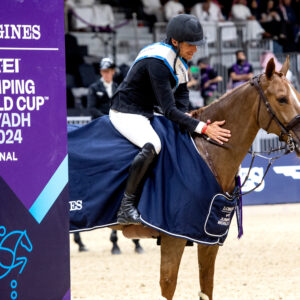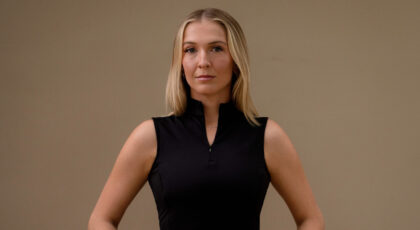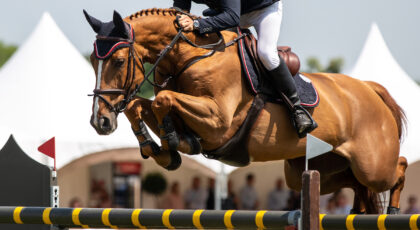Data powered by Prixview.
Outside of a most dominant squad from Sweden sweeping the gold medals at the 2022 FEI World Championships, Herning was full of surprises.
Did anyone envision McLain Ward (USA) and Contagious retiring before the final individual round? What about disobedience from Brian Moggre’s (USA) Balou du Reventon? And a fall from Jos Verlooy (BEL)?
This is just another reminder of the unpredictable nature of our sport. Absolutely anything can happen.
But numbers can help us understand why.
After taking a few days to recover from Henrick von Eckermann and King Edward’s most awe-inspiring sweep of the World Championships, we’re taking a deeper look at each of the courses throughout the five rounds of jumping.

The courses are meant to get progressively difficult at a championship, and the numbers from Herning affirm this, as the tracks produced a greater average of faults as the competition progressed. That is, of course, until the individual final. These lower numbers, however, illustrate a greater caliber of combination (and simply a fewer number of starters).
The horse-and-rider duos advancing to these final two rounds of jumping were the ones navigating the courses with the most proficiency throughout the week. Still, the second round of this final proved to be more difficult than the first, with an average score of 4.5 vs. 4.24.
Over the course of five rounds of jumping, only von Eckermann and Jérome Guery managed to come away without touching a single fence. The separation of individual gold and silver came down to time, a perfect manifestation of how our sport has modernized and how critical of an element time has come. Guery had a single time fault in the second round of team competition. He and Quel Homme de Hus also were also slower than von Eckermann and King Edward in the opening speed competition. (Eckermann finished fifth in that opening event, with Guery 17th).
Learn Show Jumping: Table C for Jumping Championships)
Where did all the decimals come from in the scores after the first round? In this unique faults converted format, scores are converted into points by multiplying the time of each athlete by the coefficient 0.5. The athlete with the lower number of points after this conversion will be given 0 penalties. The other athletes receive a score that is calculated by the difference in points between each of them and the leading athlete.

Let’s dive a bit deeper into the courses themselves. The chart above indicates the jumps that fell most often in each respective round of jumping. In four of the five rounds, the most faults were incurred in a combination.
In the opening speed round, the oxer and 5b and the open water each contributed to 28.57% of the faults on course. The open water is unsurprising, as this course element is relatively infrequent. In this instance, it came late in the course and out of a long bending line that gave riders space to gallop but also involved a related distance. 5b, meanwhile was a wide oxer that was preceded by a quite steady line. If you got up the line too easy, it required a big effort from the horse to get out of the combination and the spread of that oxer.
In the first team round, the triple combination reared its ugly head, over and over. Across the three elements, rails in the triple combination fell 48 times, contributing to a combined 30% of the rails on course. 9b, however, fell the most. The line coming into the combination was a sweeping, continuing nine strides. Coming in with such momentum made the line from 9a to 9b—a careful vertical—exceptionally tight.
The final round of team competition came on Friday, a third straight day of jumping for the horses. The most difficult element came, again, late in the course, at 13c—and again, part of the triple combination. 13c accounted for nearly 16 percent of the faults on course. Both A and B of the triple were careful verticals, but C came out of a one stride and required the horse, after jumping up, to then stretch across an oxer. That oxer was then followed by one last vertical at 14 in, a steadying line. Rideability was crucial here, and surely more than a few rails at 13C involved riders thinking about and preparing for that last line.
How special are our equine athletes? After a day of rest, there were two more rounds of jumping on Sunday to determine the individual World Champion. In the first of two final rounds, Jump 9 fell most often, but it actually had nothing to do with Jump 9. That vertical was preceded by the open water. After jumping that massive spread on an open gallop, you had to immediately collect to the next fence.
Just 12 combinations came forward for the final round, and the fence that fell most often was 10b, a Liverpool oxer. This was in fact a combination of two liverpools: vertical, oxer. The liverpool is designed to draw the horse’s eye down, distracting them from studying the height and width of the fence they’re jumping. Seeing through the in of the combination to another liverpool created quite an illusion, couple with the endurance required for one last course and a fifth round of jumping for these superior horses. Let’s just add in the fact that many horses carried a lot of forward momentum to this series of fences. A steadying line preceded this tight combination.
How did your selections fare? View all of Prixview’s coverage of the World Championships at Prixview.com and visit Prixview.com/fantasy to make your picks for this week’s games.
Feature Image: © FEI/Leanjo de Koster
Prixview is the first of its kind data and gaming company for the sport of show jumping, collecting revolutionary live, official competition data and processing it into educational and engaging insights and analytics for both stakeholders and new fans of the sport. Their fantasy games are free-to-play and award real cash prizes. Visit prixview.com to learn more.


 August 17, 2022
August 17, 2022 


























